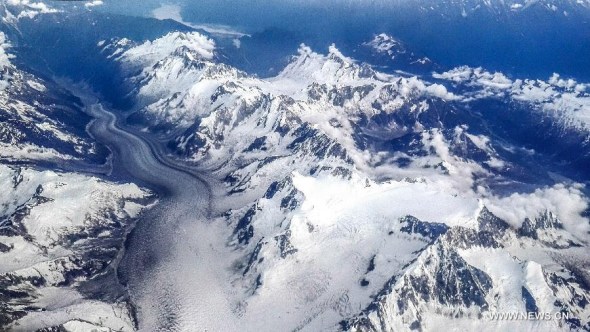
Photo taken on Aug. 3, 2015 from a flight shows the landscape of the Qinghai-Tibet Plateau, southwest China. (Photo: Xinhua/Zheng Huansong)
Glacier on the Tibetan plateau has been backing off since the 20th century due to rising temperature, and at a faster speed since 1990s, according to a report on the environmental change in the region released on Wednesday.
The scientific evaluation report on environmental change of the Tibetan plateau was published by the Institute of Tibetan Plateau Research under Chinese Academy of Sciences.
The report said, glacier's response to the climate change can be best seen in the progress or retreat of the glacier.
Glacier loss in the Tibetan plateau is most prominent in the Himalayan Mountains and the southeastern Tibet, whereas glacier stays relevantly stable, even progressing, in the Karakoram and Western Kunlun region due to increasing precipitation, the report said.
Both number and area of lakes on the Tibetan plateau increased notably. The number of lakes exceeding 1 square kilometers climbed from 1,081 in the 1970s to 1,236 in 2010, and 80 percent of lakes in the region have been expanding.
Meanwhile, due to glacier melt, increased precipitation and reduced evaporation, water level in 152 of the 200 lakes in the region with ICESat laser altimeter data rose, while that in the rest 48 dropped, the report said.
The report also forecasted that in the future from 2015 to as far as 2100, the dominant changes in water bodies of the region would be retreating glacier, reduced snow cover and rising river run-off.
The overall situation of ecological system on the Tibetan plateau is improving as the boundaries of frigid and sub-frigid zones are moving westward and northward. The temperate zone is expanding, according to the report.
The area of arctic-alpine steppe is increasing and the growth period is extending, while meadows are shrinking.
The report also noted that the area and growing stock of forest on the plateau have increased significantly since 1998, from 7.29 million hectares in 1997 to 14.72 million hectares in 2013 and 2.09 billion cubic meters in 1997 to 2.26 billion cubic meters in 2013, respectively.
The increase is mainly attributed to efforts of forestry conservation and restoration, the report said.
The scope of arable land has been expanding since the mid 1970s, which helps increase the income of farmers and herdsmen, the report said.
But the report warned of the degeneration of the wet land and frozen earth as well accelerating decertification.
It predicted that the frozen earth will continue to shrink from 2015 to 2100.
With an average altitude of over 4,500 meters, Tibetan plateau, which is known as the core of "The Third Pole," refers to the areas mainly within southwest China's Tibet Autonomous Region.


















































